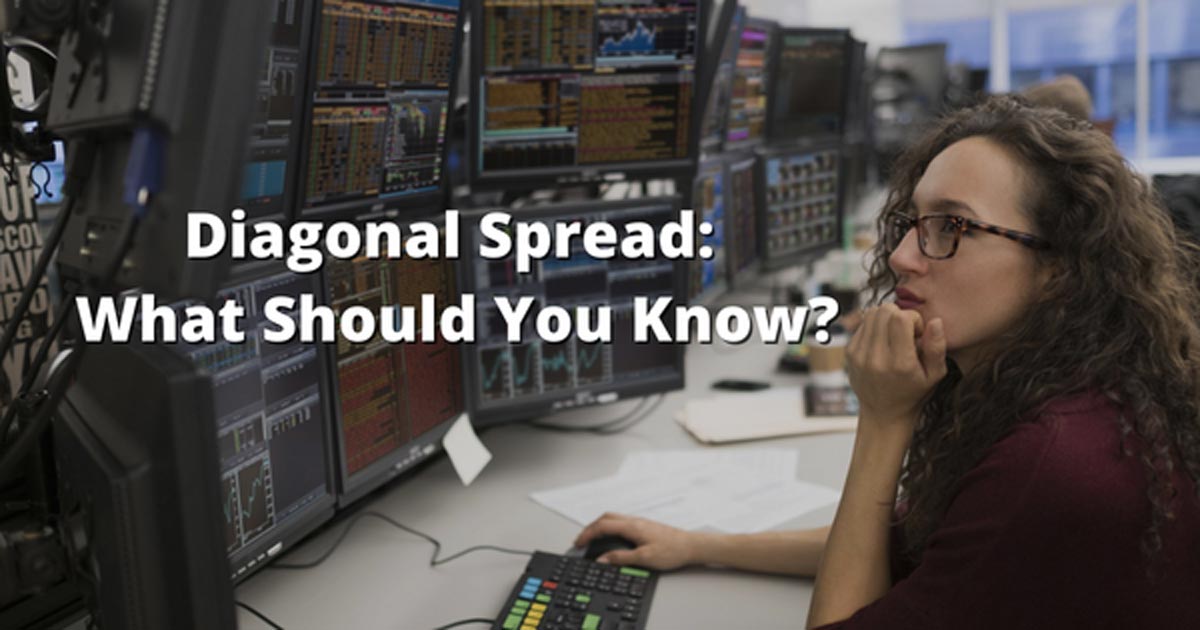Any options trader have heard of a diagonal spread, one of the effective options trading strategies. This article unfolds the related basics, such as what it is, how to adapt it, and the correlation between spread and volatility. Scroll down to this blog for more information!
1. What Is a Diagonal Spread?
A diagonal spread refers to an adjusted version of a calendar spread with different strike prices. The setup includes the entry of a long and short position in two options of the same type at different strike prices and expiry dates. It is applicable in both bullish and bearish markets.
2. How Does a Diagonal Spread Work?

The combination between a horizontal spread (time spread) and a vertical spread (price spread) makes an option diagonal spread. It refers to the positions of options on an options grid at different strike prices and expiration dates.
A horizontal spread involves a difference in expiration dates and the same strike prices. Meanwhile, a vertical spread indicates different strike prices and the same expiration dates.
So, diagonal spreads have the characteristics of both spread types. Specifically, it involves the same type of options, such as two call options or two put options, at different prices and expiry dates.
3. Types of Diagonal Option Spreads
Each option includes two elements, including strike price and expiration date. These factors also create different types of diagonal spreads, such as bullish, bearish, long, short, diagonal call spread, or diagonal put spread.
Most diagonal spreads are long spreads as long as the holder purchases the option with the extended expiration date and sells it with less maturity time.
On the other hand, short spreads ask for a shorter expiration for purchase and a longer expiry duration for sale. This requirement is alike for both call diagonal spread and put diagonal spread.
For example:
In the case of a bullish long call diagonal spread, you should buy the option that has a long expiration date and lower strike price. Then, you can sell it by maturity at the higher strike price. Specifically, you buy one November $20 call option and simultaneously sell one March $25 call option!
4. A Beginner’s Guide on Closing a Diagonal Spread

When you collect enough premium from the trade, you would like to close a diagonal spread. Otherwise, you will close the trade if the options are going to go in the money so you do not have to handle the sold options. The detailed process of closing a diagonal spread is below for your reference.
- Place a buy-to-close (BTC) order on the sold contract that is about to expire. The rule is to prioritize the close on the short side of a diagonal trade for the sake of margin requirement.
- Measure the profit potential of the remaining long option in the trade. You should identify whether the underlying asset moves in the right direction or not. The expectation of the rise comes with a call contract while put options brag the forecast of the downfall.
- Place a sell-to-close (STC) order on the remaining options in the trade. You can complete the process by or at the expiration day of that particular option.
Diagonal spreads can be an excellent strategy for your options trading. Yet, there are always risks in volatile financial markets. Due to relations to various trades, failures on diagonal spreads can lead to costly pitfalls, in terms of commissions.
Therefore, you need to equip yourself with effective risk management techniques, a solid foundation, and a strong financial backup. Hedging can be a great alternative to increase the odds of success and decrease trading risks.
5. How Implied Volatility Impacts Double Diagonals Spread
We should learn what implied volatility (IV) and double diagonals are before finding the answer.
Implied volatility (IV) is a metric gauging the possibility of changes in a security’s price from the market’s perspective to foresee the next price actions and the volume. Thus, they can ease the process of pricing options contracts.
On the other hand, double diagonals indicate the blending of a diagonal call spread and a diagonal put spread to gain the best out of the time decay.
Volatility measures the fluctuation of a stock price and the impacts on the option’s price. So, if the market becomes more tumultuous, it profoundly moves the options’ price to the upward side.
6. Maximum Profit Potential
Accurate calculation of maximal profit potential by a diagonal spread is not an easy task. The received premium after the sale of the second put option might be the reason why.
When adopting the diagonal spread options trading strategy, your profits depend on the net credit after the sale of both put options at the latter strike price.
Profit Potential = Total Profit − Premium Paid for the Put Option − Initial Strike Price
7. Maximum Loss/Risk
Calculating maximum potential profits is difficult, and the measure of maximum risk is no exception. The risk of using diagonal spreads is now under the influence of strike prices and net credit.
Case 1 – Net Credit: You can calculate the maximum level of losses through the formula below.
Maximum Risk = Strike Price A − Strike Price B − Received Net Credit
Case 2 – Net Debit: You can use the following formula to estimate the maximum risk.
Maximum Risk = Strike Price A − Strike Price B + Paid Net Debit
Some Notes
A long vertical and long calendar spread usually follows a 1:1 ratio in a debit account. Yet, the combination within diagonal spreads can generate various ratios due to different strike prices and expiration dates. Common sense is that people put on a long diagonal spread for a debit and a short diagonal spread for a credit.
Besides, the principle is to close the trade with a diagonal spread as the shorter option expires. Yet, most traders replace the expired option with another with the same strike but longer-expiration option!
In a Nutshell
We have briefly walked you through essential guides on a diagonal spread, such as its definition, its types, tips for closing it, etc. As one of the crucial strategies, the fundamentals of a diagonal spread can expand your options trading profitability. Stay tuned for our next blogs to uncover many other trading topics that can help you earn higher and take fewer risks.


